
Welcome to baltimoresnakes.com! I am David, a snake enthusiast living in Baltimore, MD. Many people don't know that Baltimore is in fact full of snakes! You just need to know where to find them - they can often be shy and elusive. Some Maryland snake species are more common outside of the city limits, in different parts of Baltimore City County MD, but many types of snakes are indeed common in the more urban parts of Baltimore. This guide is meant to help educate you about the beautiful snakes of Baltimore, and to help you identify the most common snakes of Baltimore, as well as the venomous snakes of Baltimore that you should learn to recognize and avoid. If you want more detail, click here for my complete list of ALL snake species in Baltimore. Remember the following:
- Most snakes of Baltimore are harmless and don't want to encounter you
- Venomous snakes exist but are uncommon in Baltimore, Maryland
- Snakes eat rats and mice and are a valuable part of the Maryland ecosystem
- Never kill a snake - if you leave a snake alone, it will leave you alone.
Common Snake Species in Baltimore
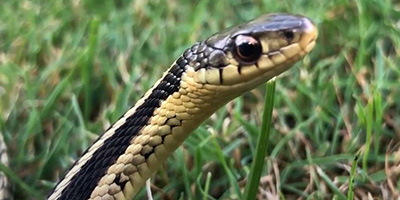 Garter snake:
Garter snakes are beautiful reptiles that come in a variety of colors. They can be green, black, or brown but usually, they have a white or yellow
stripe that runs down the back of the body. The eastern garter snake species is known to be one of the most abundant snakes in Baltimore. Garter
snakes can grow large, with some reaching up to 26 inches in length. They are commonly found around water sources, forests, marshes, or even the backyard.
Garter snake:
Garter snakes are beautiful reptiles that come in a variety of colors. They can be green, black, or brown but usually, they have a white or yellow
stripe that runs down the back of the body. The eastern garter snake species is known to be one of the most abundant snakes in Baltimore. Garter
snakes can grow large, with some reaching up to 26 inches in length. They are commonly found around water sources, forests, marshes, or even the backyard. 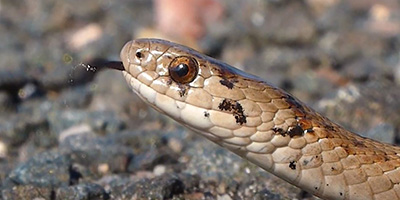 Northern brown snake:
While the rat snake is one of the biggest snakes found in Baltimore, the northern brown snake is directly the opposite. Growing to a maximum length of 1
foot, the northern brown snake is one of the smallest in Baltimore. Many of them are brown with black or dark brown spots that run along the back although
they can also appear grey or reddish. Northern brown snakes are abundant in Baltimore, but the chances of sighting one are slim as they mostly come out on a
hunt at night. The snake can flatten itself, giving off the appearance of a larger snake when threatened. Although they are not venomous, northern brown snakes
are able to deliver painful bites.
Northern brown snake:
While the rat snake is one of the biggest snakes found in Baltimore, the northern brown snake is directly the opposite. Growing to a maximum length of 1
foot, the northern brown snake is one of the smallest in Baltimore. Many of them are brown with black or dark brown spots that run along the back although
they can also appear grey or reddish. Northern brown snakes are abundant in Baltimore, but the chances of sighting one are slim as they mostly come out on a
hunt at night. The snake can flatten itself, giving off the appearance of a larger snake when threatened. Although they are not venomous, northern brown snakes
are able to deliver painful bites. 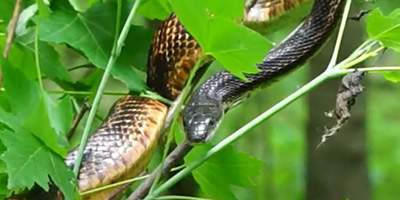 Rat snake:
The rat snake is considered one of the largest snakes found in Baltimore. It can grow up to 80 inches long. As intimidating as its size is though, rat snakes are
not aggressive. They feed predominantly on rats and mice and can significantly help lower a rat infestation in an area. Rat snacks are mostly black with some white
markings on their body. They can be found around rocky areas and flatlands as well.
Rat snake:
The rat snake is considered one of the largest snakes found in Baltimore. It can grow up to 80 inches long. As intimidating as its size is though, rat snakes are
not aggressive. They feed predominantly on rats and mice and can significantly help lower a rat infestation in an area. Rat snacks are mostly black with some white
markings on their body. They can be found around rocky areas and flatlands as well. Venomous Snake Species in Baltimore
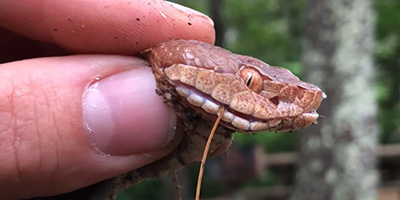 Northern copperhead:
The northern copperhead is another venomous snake found in Baltimore. Although they don't grow as big as timber rattlesnakes, they can grow up to 53 inches in length.
Many people may confuse northern copperheads with rattlesnakes by the sound they make. When northern copperheads are threatened, they may vibrate their tails. This
vibration can feel like a rattle when it hits grass and vegetation around, causing people to mistake them for rattlesnakes. Northern copperheads, however, do not have
rattles on their tails.
Northern copperhead:
The northern copperhead is another venomous snake found in Baltimore. Although they don't grow as big as timber rattlesnakes, they can grow up to 53 inches in length.
Many people may confuse northern copperheads with rattlesnakes by the sound they make. When northern copperheads are threatened, they may vibrate their tails. This
vibration can feel like a rattle when it hits grass and vegetation around, causing people to mistake them for rattlesnakes. Northern copperheads, however, do not have
rattles on their tails.
The northern copperhead is reddish-brown or copper in color. It may have 2 shades of this color. Its head has a copper color and throughout its body, the darker shades form a shape resembling an hourglass over the lighter color. This pattern runs throughout the back of the snake. The unique color of the northern copperhead helps to blend in when it is lying in leaf litter.
Northern copperheads are venomous snakes that release hemolytic venom. Their venom breaks down the red blood cells. Although copperheads cause many snake bite cases each year, their bite is rarely fatal. When threatened, copperheads may strike or run away.
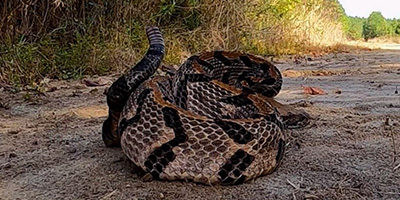 Timber rattlesnake:
Timber rattlesnakes, also known as canebrake rattlesnakes, are large venomous snakes with a distinctive rattle at the end of their tails. They can grow up to 6 feet
long. Timber rattlesnakes are usually gray but many species have either a pinkish, yellowish, or orange stripe that runs down the length of the back. They can mostly
be found in swamps, mountainous areas, and forests. Timber rattlesnakes are active both at night and during the daytime but most of their time is spent curled up,
waiting for prey to ambush. Although rare, timber rattlesnakes will bite and can deliver life-threatening venom when threatened.
Timber rattlesnake:
Timber rattlesnakes, also known as canebrake rattlesnakes, are large venomous snakes with a distinctive rattle at the end of their tails. They can grow up to 6 feet
long. Timber rattlesnakes are usually gray but many species have either a pinkish, yellowish, or orange stripe that runs down the length of the back. They can mostly
be found in swamps, mountainous areas, and forests. Timber rattlesnakes are active both at night and during the daytime but most of their time is spent curled up,
waiting for prey to ambush. Although rare, timber rattlesnakes will bite and can deliver life-threatening venom when threatened. If you're unsure, you can email me a photo of the snake at info@baltimoresnakes.com and I will email you back with the snake's species. If you found a snake skin, read my Found a Skin? page, and you can email me a photo of the skin, and I'll identify the snake for you. If you need professional Baltimore snake removal help, click my Get Help page, or see the below website sponsor I found, who provides that service.
The Northern Water Snake
There are many people living in North America who will come across the Northern Water Snake (Nerodia sipedon), but because of its range of colors and fairly large size it is commonly mistaken for other species. The large population of the species does belie the fact that a subspecies of the Northern Water Snake that was exclusive to the area around Lake Erie was under threat of extinction, but has recovered over recent years.
Appearance And Diet
The Northern Water Snake is one of the largest snakes to be found in North America, and the largest examples can grow up to a length of four and a half feet. The snake has quite a heavy body and has quite a large head which is in proportion with the body of the snake. The Northern Water Snake can be found in a variety of colors, but the majority will have bands of brown, black and dark green, although they can also have a sandy or reddish color on the body. As the snakes get older their color will darken, and the older adult snakes will actually have a body that is almost entirely black. They also enjoy quite a varied diet depending on the species present in their habitat, with some snakes eating small mammals, amphibians, invertebrates and fish. The Northern Water Snake will eat almost any animal that it can find, and is often considered to be a beneficial species because of its preference for eating pest species such as mice. They will often show a preference for hunting in the water at night, catching minnows and other small fish. One interesting aspect about the Northern Water Snake is that while it isn’t venomous, its bite does introduce a small amount of an anticoagulant which prevents the wound from healing properly.
Behavior And Habitat
The Northern Water Snake is not a snake that will actively seek a confrontation with other animals and people, but it is worth noting that they will defend themselves if threatened or picked up. They can deliver a nasty bite that would require medical attention in this instance, and are likely to bite repeatedly unless they are released. They can also release a pungent musk and excrement if threatened, but in reality the snake itself poses very little risk to people as long as they are left alone. They are generally solitary creatures and will live by themselves apart from during the mating season, and also during hibernation where they will often share a nest with other snakes. The color of the Northern Water Snake means that it is commonly mistaken for the venomous Cottonmouth and the Copperhead, but it behaves very differently. While the venomous species are likely to bare their mouth to a threat, the Northern Water Snake will usually flee into the water rather than confront any direct threat. As the name of the snake suggests, this is a species that is mainly at home in and around water, and can be found on the banks of lakes and rivers. They do enjoy basking on rocks and exposed areas during the daytime, but are also adept swimmers when they go into the water to hunt during the night. This common species can be found across North America, but are especially common near beaver and muskrat dens where the plants provide plenty of cover which they do prefer. They are also most numerous in south east Canada and in the north eastern states of the USA.
Reproduction And Growth Cycle
The female snakes are usually much larger than their male counterparts, and the mating season will last from April when they emerge from hibernation through until June. The gestation period for the female can vary between three and five months, culminating in a single litter of around thirty live snakes between August and October. The Northern Water Snake doesn’t have any maternal instincts, and these young snakes of around seven to nine inches in length will be immediately left to fend for themselves. The young snakes will grow quite quickly for the first couple of years, doubling in size by the time they are two years old, when they become sexually mature. From the third year onwards the Northern Water Snake will continue to grow, but at a much slower pace. As they get older, they will also become darker in color. Snakes that have been kept in captivity have been known to live up to ten years, but there is very little evidence about the life span of the Northern Water Snake in the wild.
Predators
Although the Northern Water Snake is one of the larger species of snakes in the United States, it does have a number of predators including foxes, opossums, raccoons, snapping turtles and other snakes. Because of the array of predators, they will usually flee into the water at the first sign of a threat. Remember, the term is not poisonous snakes of Baltimore, it's venomous snakes of Baltimore. Poison is generally something you eat, and venom is injected into you. That said, dangerous snakes are very rare in Baltimore. The few venomous snakes of Baltimore City County are rarely seen. But they are commonly misidentified, so learn about all the snake species of Baltimore in order to correctly identify them. These snakes are usually also found in the surrounding towns of Townson, Dundalk, Owings Mills, Catonsville, Pikesville, White Marsh, Essex, Parkville, Cockeysville, Lutherville-Timonium, Middle River, Perry Hall, Woodlawn, Randallstown, Rosedale, Reisterstown, Arbutus, Milford Mill, and the surrounding areas.
Read our article about:
Understanding The Black Rat Snake: Appearance, Biology, Life Cycle, Habitat, Diet, Behavior
baltimoresnakes.com domain and hosting costs made possible by the generous support of this sponsor:
